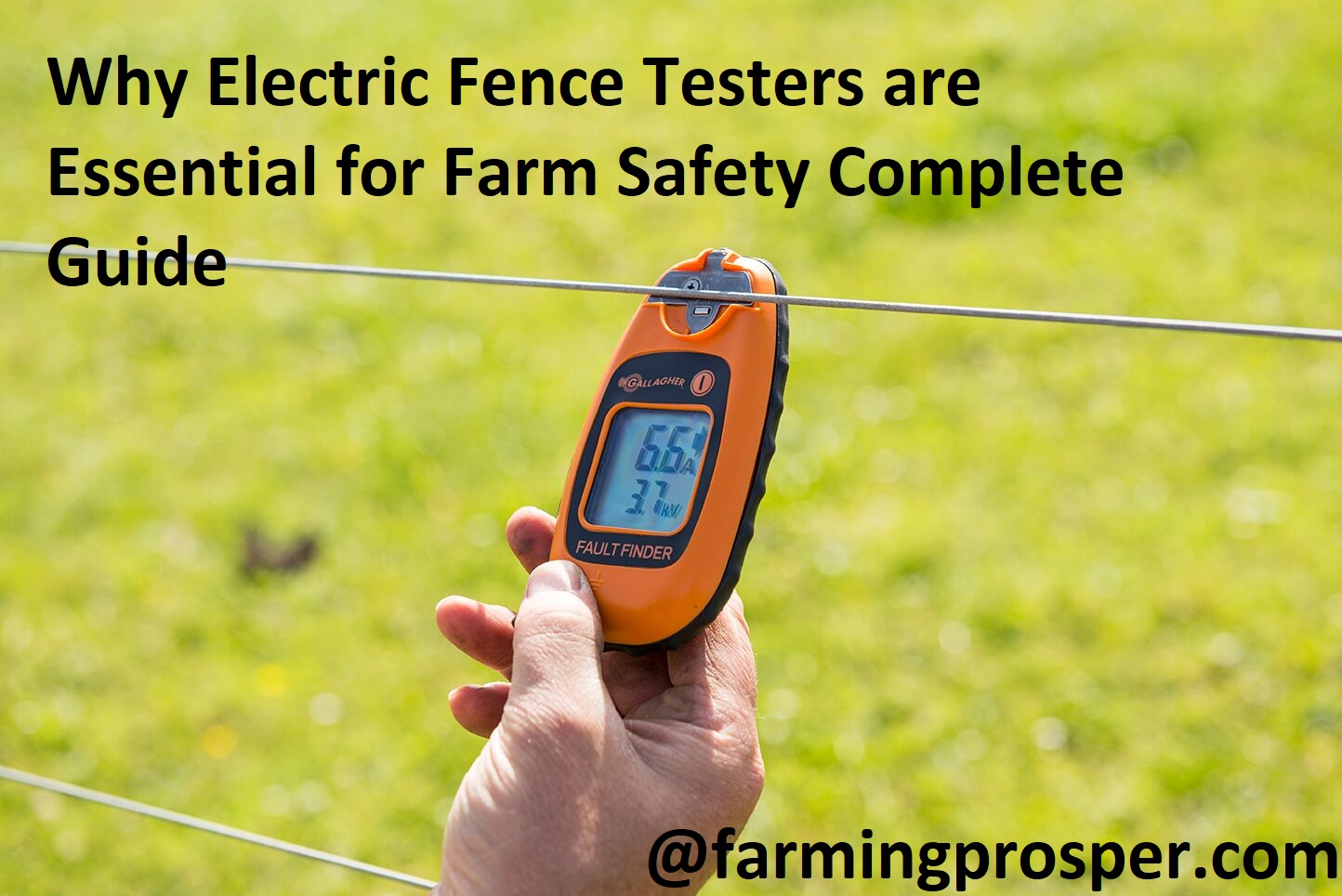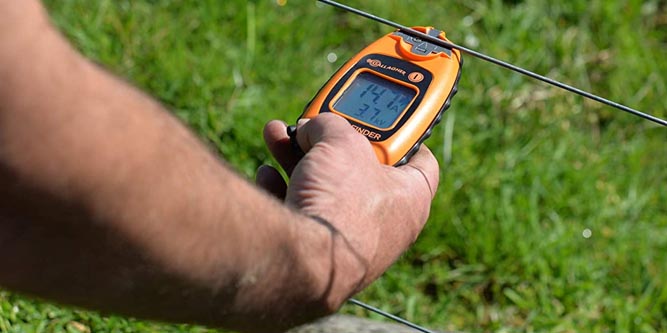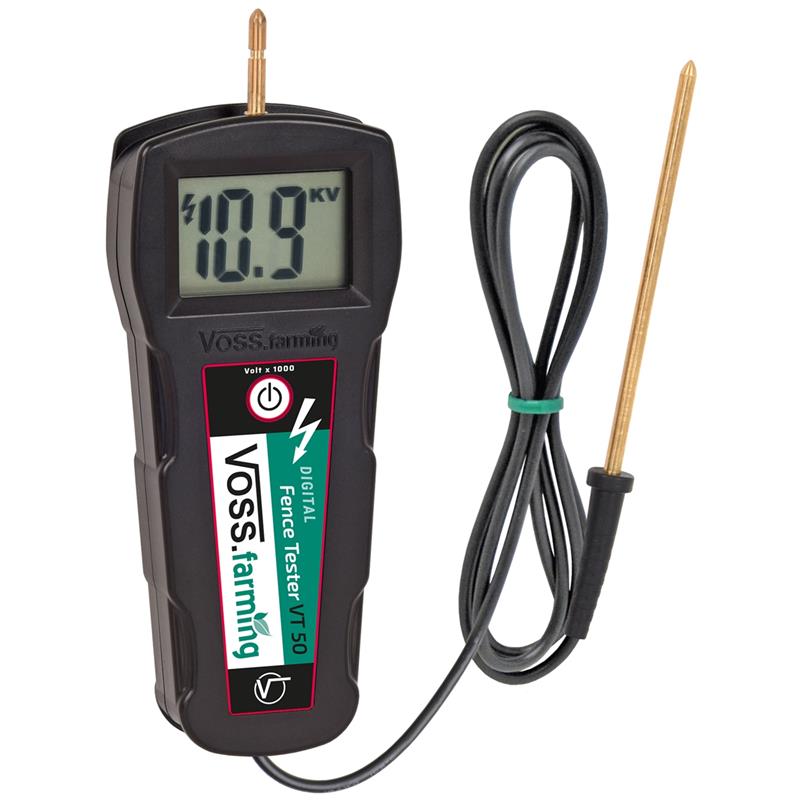Are you concerned about your farm safety? Electric fence testers are a must-have tool to ensure the safety of your livestock. It can help you manage, monitor, and diagnose the health and power levels of your electric fences.
In this guide, we’ll explain why electric fence testers are essential for farm safety. You won’t want to miss it!
Electric fencing is a safe, simple and reliable solution to keeping large livestock or other animals contained. Electric fences are an effective way to protect facilities and keep animals away from areas that should be off limits, such as busy highways, dangerous cliffs or streams.
However, with any electric fence system, it’s essential to make sure that the power levels, grounding and entire circuit are monitored properly. Problems in any of these three components can mean a weakened fence or even one that doesn’t work. The best way to ensure the safety of your electric fence is to use an Electric Fence Tester.
This guide gives a detailed explanation of what an electric fence tester is, how it works and why it’s essential for farm safety. With this tool in your hands, you’ll have peace of mind knowing that your electrified farm is secure and the animals you tend are safely contained.
Importance of farm safety
Farm safety is of utmost importance; not only to ensure the safety of the animals that you’re raising, but to protect your farm from theft and vandalism. To help ensure the safety of your valuable farm and its animals, installing an electric fence system to deter trespassing is essential. However, just installing a fence isn’t enough; it’s essential to maintain it and make sure that it stays in good working order. That’s why electric fence testers are an important tool for any farmer or rancher looking for reliable protection for their property.
Electric fence testers help you monitor and maintain the current of your electric fence by measuring the voltage inside the wire in increments as small as one hundredth of a volt. This means that you will be able to tell if there are any shorts or spikes in the wire caused by rust or animals chewing on it. They will also allow you to measure ground resistance, which is important in determining whether or not animals can easily break through your fencing system due to poor connection at each end post.
Finally, they can be used to check current flow over time so that you can easily identify issues such as weak batteries, weak connections between posts and even improper grounding which all can affect your fence’s effectiveness in keeping intruders out. By regularly testing these factors with a quality tester, you’ll be able to reduce risk associated with livestock escapes or animal injury before they become serious problems on your farm.

Introduction to electric fences
Electric fences are widely used on farms and agricultural land for the purpose of containing livestock and protecting crops. The electricity within the fence produces a shock that serves as a deterrent and keeps animals in (or sometimes out) of an area. While they can provide excellent protection, they must be properly maintained, including regularly testing their strength to make sure the voltage is suitable for their purpose. This is why electric fence testers are essential items in any livestock farmer’s toolkit.
Electric fence testing isn’t complicated but it does depend on understanding both how wiring works with electric fences and on how electricity behaves around different types of wires, grounding methods, and components in order to correctly interpret results. This guide provides introductory information about electric fences as well as tips and considerations about using an electric fence tester for field testing an electric fencing system on a farm or ranch.
Overview of the guide
This comprehensive guide will explain why electric fence testers are essential for farm safety. It covers the basics of electric fencing, considerations when selecting a tester, and steps you can take to ensure your fencing system is operating safely.
We’ll start by looking at the anatomy of a typical electric fence system. We’ll then consider why it’s vital to use an appropriate tester, gauging factors such as power output, portability and the digital display features offered. Finally, we’ll explore how you can use your tester to test different components of the fence and troubleshoot any issues.
By taking each step of this guide in turn and being aware of safety guidelines when using an electric fence tester, you will be able to use your tester with confidence retaining peace of mind that your fences are secure.
Why Electric Fence Testers are Essential
When used in conjunction with other safety precautions, electric fences can be an effective way to prevent animals, children and pets from coming into contact with live fences. However, it is essential to regularly check the fence and ensure that it is functioning properly. The best way to do this is with an electric fence tester.
An electric fence tester will help you to identify any problems or faults with your electric fence before they can become a hazard. Electric fence testers provide a combination of measurements that are designed to detect even the smallest faults within an electrical system. By connecting one end of the tester probe to the live wire, and then placing the other end of the tester probe on each terminal post in succession, you can quickly and easily check for faults in your fencing system. Any irregularities or faults will appear as a flashing light or bleep on the electric fence tester’s display screen, informing you that corrective action needs to be taken.
An effective electric fence testing system also includes additional features such as automatic alerts when testing results indicate an issue or fault within your fencing system. This alert function allows you to rectify any problems immediately and reduces the risk of potential safety hazards due to faulty wiring conditions or incorrectly constructed terminals and posts. In addition, some systems include features that allow you to store recorded test data, enabling accurate recall later if needed for analysis purposes.
As well as being essential for farm safety purposes, electric fence testers are also invaluable when studying electronic circuits at a more advanced level – including detecting circuit resistance value variations and enhancing fault tracking performance on complex electrical systems such as current sensors controlling inverter systems powering solar panel installations.
How to use an electric fence tester
Electric fence tester is an essential tool for farm safety. It helps you check the performance of electric fences so you can ensure they are operating correctly. This tool is also used to troubleshoot any issues that may arise with your electric fence, such as a weak signal or inadequate fencing.
Below are steps on how to use an electric fence tester:
- Connect the tester probes to the terminals at either end of the electric fence wire, this should be done using insulated protective gloves and a belt clip providing additional protection.
- Turn on the fence energiser and set its voltage output to the manufacturer’s recommended setting if required by your specific device. Preparatory tests should be conducted without livestock nearby for safety reasons.
- Readings from an analogue-style meter will appear as a red needle on the scale, whereas digital testers will display with numbers in volts or kiloVolts (kV).
- Check that all readings are above 0V (0kV), ideally some considerable distance from 0V (0kV) as this indicates good insulation throughout your system, meaning it should prevent livestock from going near certain parts of the farm that need to be kept off limits for health and safety reasons.
- Once all readings have been taken, remember to de-energise the fence until any needed maintenance is carried out before reactivating it again.
Benefits of using an electric fence tester
An electric fence tester is an essential tool for managing the safety of your electric fences, and it can provide you with numerous benefits. By using a tester, you will be able to check the power of your fence without putting yourself or other livestock at risk. Additionally, testers are designed to be reliable and accurate when measuring voltage levels so they are strongly recommended over other methods.
Testers also provide you with more information, as they allow you to compare different portions of the fence line to identify where adjustments may need to be made. This can save you time and effort in the long-term. Furthermore, electric fence testers are relatively easy to use and come with easy-to-follow directions for those just getting started with using them.
A final benefit of using a tester is safety; by testing your fences with a tester, instead of by touching it or throwing an object on it first, any risk of shocks or damages from broken wires is minimized considerably. Electric fence testing helps ensure that farm animals have adequate protection without having to worry about any potential dangers from electric shocks or painful jolts from hot wires.

How electric fence testers improve farm safety
The use of electric fence testers is vital for the safe maintenance of electric fences. By using an electric fence tester, users can quickly identify any potential problems with the fence, and take action to fix them if they so choose. Electric fence testers measure the voltage output of the fencing system, as well as its efficiency in carrying power around its entire length. This information can be used to detect any faults or areas in which power has become ‘dead’ or diminished for whatever reason – ensuring that livestock will not escape or come into contact with dangerous amounts of electricity.
Electric fence testers help improve safety by allowing users to test various components before installation. In particular, they are used to perform continuity and resistance tests on wires, posts and insulators, helping users identify any problem areas before construction begins. For example, it is important to check whether wiring between posts is correctly insulated; if it isn’t, it could cause shorts (short circuits) which would reduce the effectiveness of the fencing system overall. This can be quickly identified with an electric fence tester and remedied if necessary.
Furthermore, testers are invaluable when making quick repairs in a pinch; in cases where a fault appears suddenly post-installation (for example a wire on the grand scale begins flashing red), they can provide insight that allows users to swiftly troubleshoot and fix issues without endangering livestock or themselves in the process – no guesswork required! Ultimately, electric fence testers provide farmers with peace of mind while maintaining their fencing systems: As soon as a red light appears on a tester unit at a certain location along the fencing circuit – even without further analysis – you know immediately that there’s something wrong there!
Factors to Consider When Choosing an Electric Fence Tester
When selecting an electric fence tester, it is important that you consider all of the features available and choose one that will be suitable for your needs. Three factors to think about when purchasing an electric fence tester include battery power, terminals, and display type.
Battery power – Electric fence testers are powered by batteries ranging from 4V to 12V. The cost and convenience factor increases with increasing battery voltage. However, higher voltages require more juice and may also mean that the unit will be heavier or less portable.
Terminals – Quality electric fence testers should come equipped with a terminal block allowing for several low-resistance connections and ferrules for easy connections to steel posts. Consider how many terminals you need before making a purchase–some models only have a few while others can have up to nine different terminals or pins to test multiple fences at once.
Display type – Most electric fence testers include either LCD or LED displays which can range in size from 2” up to 6” depending on the model. An important feature to look out for is whether the display is illuminated so you can easily check readings even in dark conditions. Additionally, some newer models come with backlit LCD displays which allow for easier readings even in bright sunlight conditions.
Type of electric fence
There are several types of electric fences available, each designed to provide safety and security for animals or property through a regulated system of wires powered by an energizer. Some examples of the different types of electric fences include Permanent, Semi-permanent, Poultry and Poly-tape Fences.
Permanent Electric Fence: This type of fence is permanent in nature and can be made out of metal or wooden posts with insulators attached along the fencing to support plastic electrical wire or poly-tapeline. It is placed around the animal or property you intend to restrict access to, providing a lethal shock when touched in order to act as an impenetrable barrier.
Semi-Permanent Electric Fence: This type of fence is suited for temporary installation situations such as when farmers need to divide their fields into smaller sections. It consists of fiberglass rods coated with heavy rubber insulation. The rods are then pushed into the ground, creating a U shape which energizes a single wire placed across the top.
Poultry Electric Fence: Poultry electric fences are most commonly used in poultry pens and chicken coops as they produce a low voltage current perfect for keeping predators away from birds. They make use of plastic netting draped over real or plastic posts with insulators supporting electrical wire running along the top at several strategic points throughout the pen.
Poly Tape Electric Fence: Poly tape fences are one of the most common forms today due to their ease-of-installation and relatively low cost compared with other types on the market. As its name suggests, this type uses wide flat ribbons made from polyethylene material instead traditional fencing such as barbed wire or mesh panels because it produces a visible barrier that keeps animals contained without injury causing edges that other barrier methods provide. To make it electrified, grounded lines using solid core galvanized steel wire connect back to battery operated AC or solar powered energizers which can be either mounted on posts along the circuit would be necessary for consistently holding voltage levels even during off peak times in demand hours when effectiveness tends to decrease significantly.
Voltage rating of the electric fence
Before considering an electric fence tester, it is important to know the voltage rating of your electric fence. Electric fences are typically built to run on 110, 12-220V or 12-110v AC power and the voltage will depend on what type of energizer you are using. Most testers can be used with a variety of voltage ratings, but it is best to double check before purchasing one.
When selecting a tester, make sure that it can handle more than the shield power that you plan to use in order to get accurate readings. In addition, look for a tester that has a two-year warranty so you know it is covered against defects and wear and tear.
Features of electric fence testers
In order to ensure that an electric fence is installed properly and functions without fail every day, a reliable electric fence tester is essential. The most advanced models come with a variety of features including:
-Voltage – Selectable voltages let the operator measure the proportion of current that is reaching the fence from the energizer.
-Leakage – This feature tests for any short circuits or leakage in the system, ensuring maximum safety for both people and animals near the fence.
-Ground Resistance – A good ground connection is critical for efficient performance, so it’s important to use an electric fence tester to make sure that wire resistance doesn’t exceed Safe Operating Levels (SOL).
-Waveform/Current Profile Analysis – This feature records and stores electrical data allowing you to analyze it at a later time. For example, if there was an issue with your electric fence you can view the data to pinpoint exactly what went wrong.
-Battery Level Indicator – Some electric fence testers are equipped with this helpful feature that alerts you when it’s time to recharge your battery so you don’t miss out on any workday performance.
These are just some of the features you can find in a modern electric fence tester, but there are more available depending on which model you choose.
Price and affordability
The cost of purchasing and installing an electric fence tester can vary depending on the type of tester, the size of the area to be tested as well as other factors such as labor and materials. While it may not be the most inexpensive item to purchase and install, most farmers find that they actually save money in the long run due to their reduced electric fence maintenance costs. The price of an electric fence tester should factor in safety testing times which help ensure that livestock or crops contained inside or by the fences remain safe. Additionally, electric fence testers can also help farmers detect damaged wiring and loose posts which could result in serious injury if left undetected.
Electric fence testers offer a great value for money because they reduce fencing maintenance costs while providing peace of mind that fences are regularly tested. Installing an electric fence tester also increases overall farm safety, helping protect both livestock and humans from harm. It is important for farmers to determine their individual needs when deciding which type and size of tester to purchase in order maximize installation efficiency and cost-effectiveness.

Conclusion
In conclusion, the use of electric fence testers is essential to maintaining safety on farms and ranches. They are an inexpensive way to test current and voltage levels on fences through their visible displays. Electric fence testers are easy to install, operate, and monitor, giving growers peace of mind. They also help to identify faults quickly so that you can prevent costly damage or injury due to electrical shock.
All in all, electric fence testers help small farmers and ranchers ensure a safe environment for their livestock and employees.
FAQ
What is an electric fence tester used for?
An electric fence tester is used to check the voltage of an electric fence.
What is the importance of electric fence?
Electric fences are important for keeping livestock and other animals contained and safe from predators.
What is the safety of electric fence?
Electric fences can be safe if installed and maintained properly, but they can also be dangerous if not handled with care.
What are the advantages and disadvantages of electric fence?
Advantages of electric fences include low cost, ease of installation, and effectiveness in keeping animals contained. Disadvantages include the potential for injury to animals or humans, and the need for regular maintenance.
How can fences be a safety problem?
Fences can be a safety problem if they are not properly maintained or if they are not designed with safety in mind. For example, fences with sharp edges or protruding wires can injure animals or humans.
What is the best fence for safety?
The best fence for safety depends on the specific needs of the situation. However, fences that are well-maintained, properly designed, and made from high-quality materials are generally the safest.
Why do farmers use electric fences?
Farmers use electric fences to keep their livestock contained and safe from predators, as well as to protect their crops from wildlife.
What is the importance of fencing in agriculture?
Fencing is important in agriculture because it helps to keep livestock contained and safe, protects crops from wildlife, and can help to prevent soil erosion.
What are the advantages electric fence on agriculture?
Advantages of electric fences in agriculture include lower cost compared to traditional fencing, ease of installation, and effectiveness in keeping animals contained.
What is the working of electric tester?
An electric tester works by measuring the voltage of an electric fence. It typically consists of a probe that is touched to the fence, and a display that shows the voltage reading.
See Also :
- Best incubator for duck eggs 2023
- Best barbed wire for cattle 2023
- Best milkhouse heater 2023
- Best cattle ear tags 2023
- Best rotary tiller for tractor 2023


